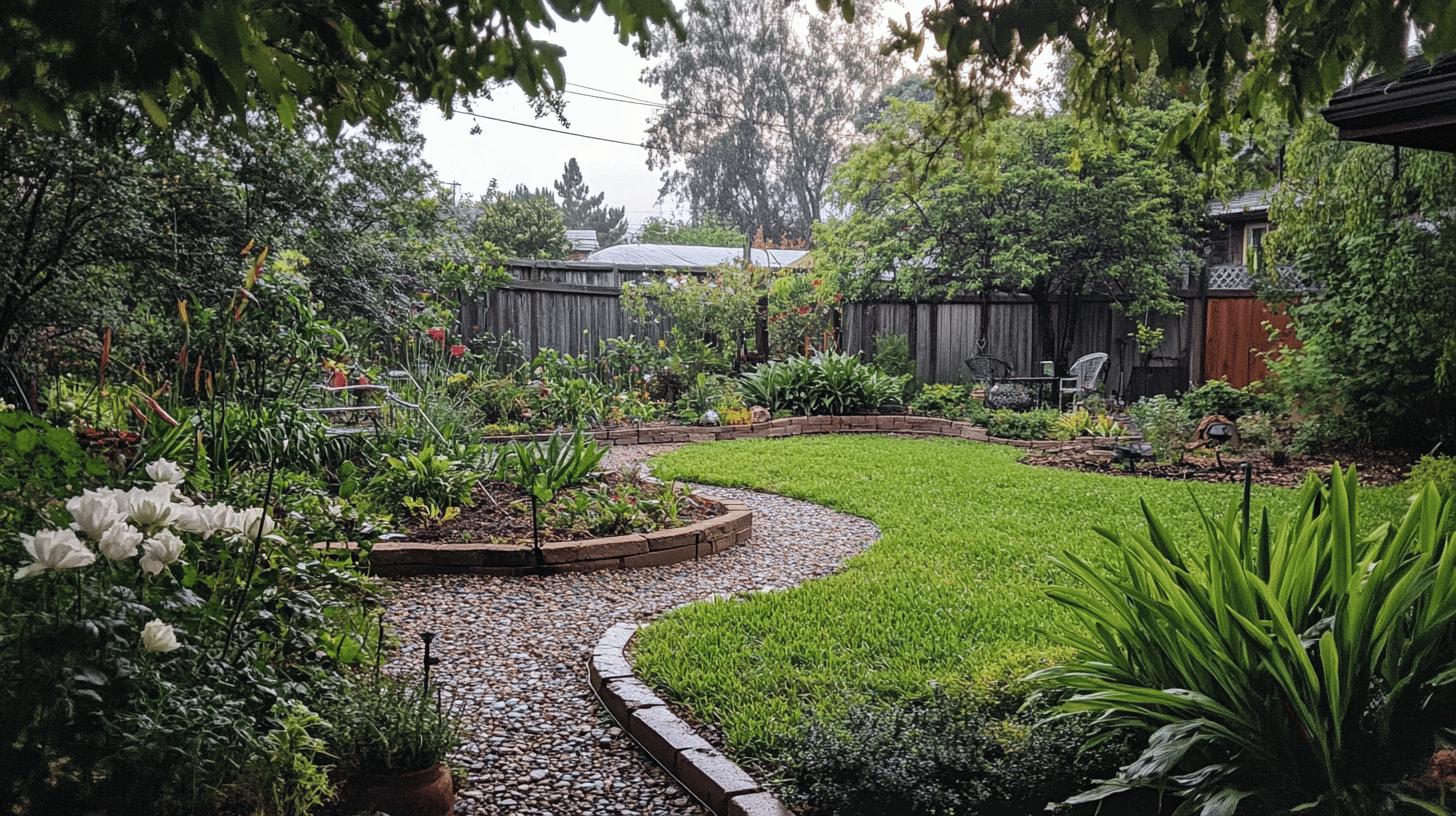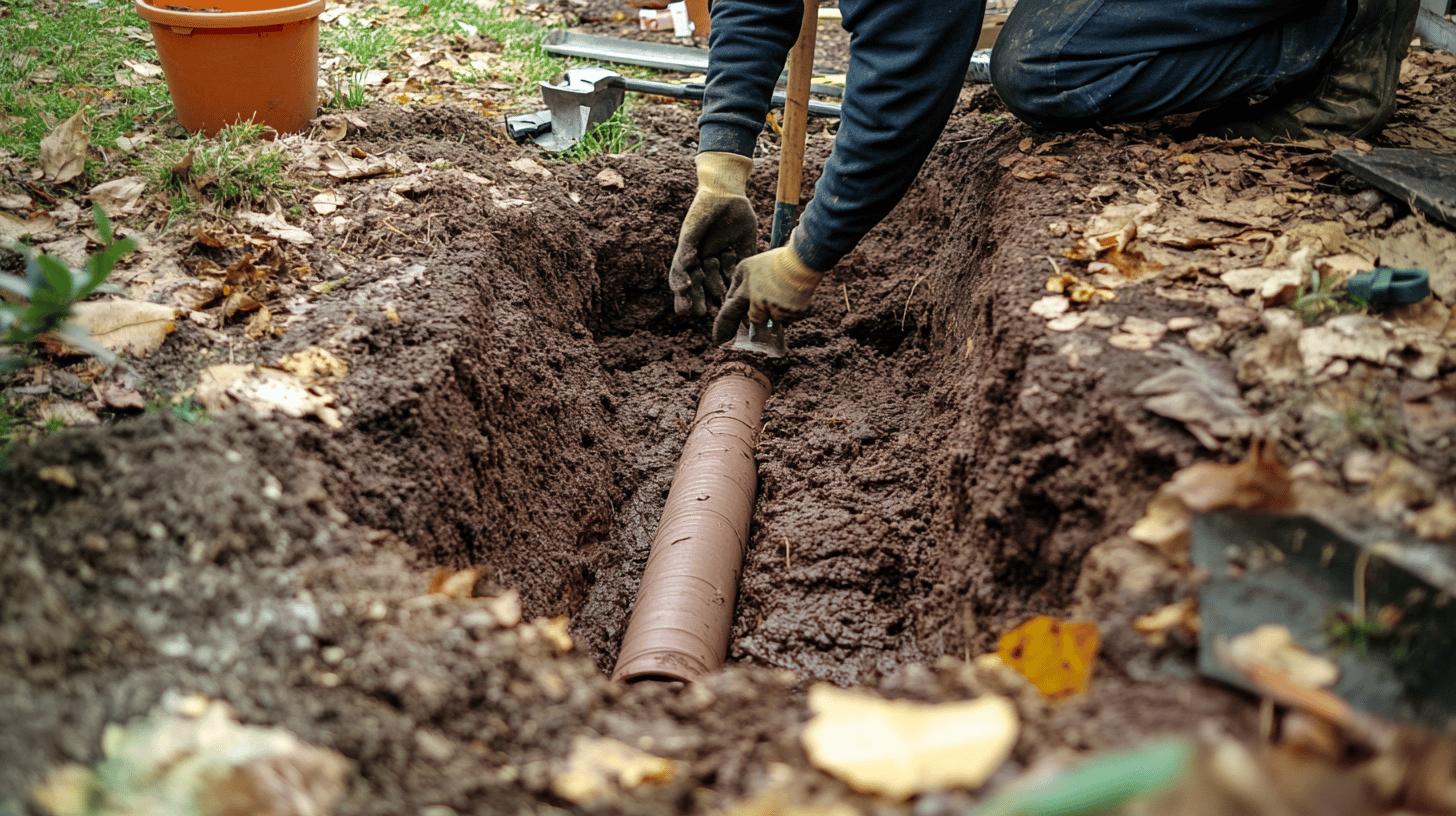TL;DR:
- Gutter drains should be installed at least 12 inches deep to prevent damage and ensure efficiency.
- Factors affecting depth include soil type (clay vs. sandy), climate (rainfall levels), property slope, local regulations, and surface activity.
- Maintain a trench slope of 1 inch per 10 feet to channel water away.
- Use appropriate tools: trenching shovel, measuring tape, and level.
- Common mistakes: ignoring local codes, insufficient depth, and incorrect pipe placement.
- Regular maintenance is crucial to prevent clogs and extend the lifespan of the drainage system.
Are your gutter drains buried deep enough to keep your home and garden safe? It might not seem like a big deal, but how deep you dig those drains really matters for managing water around your property. In this article, we’ll look at what you need to know to find the right depth for your gutter drains so they can effectively direct water away and protect your home. By getting the trench depth and slope right, you can prevent water damage and keep water flowing smoothly away from your foundation. Check out this guide to make sure your gutter drains are set up correctly!
Understanding the Ideal Depth for Gutter Drains
Not sure how deep your gutter drain should be? To get the best results, you should bury it at least 12 inches deep. This depth helps protect the drain from damage caused by things happening on the surface and makes sure water drains efficiently. Getting the depth right also helps prevent blockages and keeps water away from your home, reducing the risk of damage to your foundation.
Factors Affecting Gutter Drain Depth
Several factors influence how deep your gutter drain needs to be:
- Soil Type: Different soils drain at different rates. Clay soils may need deeper trenches for proper drainage, while sandy soils might not.
- Climate: Areas with lots of rain might require deeper drains to handle the extra water and avoid overflow.
- Property Slope: If your land slopes gently, you might need to plan trenches carefully to direct water effectively.
- Local Regulations: Building codes often specify how deep and steep gutters should be.
- Surface Activity: High-traffic areas might need deeper gutters to avoid damage from pressure.
Keeping the trench at the right depth and maintaining a slope of 1 inch for every 10 feet is key for good drainage. This slope helps direct water away from your home and cuts down on the chance of pooling. When everything’s installed properly, it not only protects your home but also makes your drainage system work better.
Factors Affecting Gutter Drain Depth

Understanding what influences gutter drain depth is important for managing water and avoiding damage. Before you install your gutter drains, make sure to check these factors to ensure they’re set at the right depth.
Soil Type and Composition
So, how does the type of soil affect how deep you should dig your gutter drain? Well, it matters a lot! For example, clay soil holds onto water, so you’ll need to dig deeper trenches to make sure the water drains properly. On the other hand, sandy soil lets water flow right through, which means you might not need to dig as deep. Checking your soil type is super important to figure out the best depth for your gutter drain so that water flows away effectively.
Climate and Rainfall Patterns
Climate plays a big role in how deep your gutter drains should be. If you live in a place that gets a lot of rain, you’ll probably need to dig deeper drains to handle all that water and prevent overflow. Thinking about the weather in different seasons helps you figure out the right depth for your drains so they work well all year round.
Property Layout and Slope
How does the slope of your yard affect how deep you dig your gutter drains? The layout of your property and how steep it is will determine the depth of your gutter drains. If your yard has a gentle slope, you might need to dig the trench just right to make sure water flows away from your house. Checking out your yard’s slope helps you figure out the best depth for the drains so water can flow smoothly.
Local Building Codes
Why are local codes important for how deep you dig your gutter drains? Local regulations often set the rules for how deep drainage trenches should be and what slopes to use. Sticking to these rules helps you avoid legal problems and makes sure everything is installed correctly. Knowing your local codes means your drains will meet the standards and work the way they’re supposed to.
Tools and Techniques for Measuring Gutter Drain Depth
Getting the measurements right is super important when installing gutter drains to avoid problems down the line. Using the right tools makes a big difference. Grab a trenching shovel, measuring tape, and level to ensure everything is precise. These tools will help you find the right depth and slope for your drainage system to work well. Being prepared with these tools will help you dig a trench that keeps your home safe from water damage.
To measure and mark the trench:
- Gather Tools: Have a trenching shovel, measuring tape, and level ready.
- Prepare the Site: Clear the trench area of debris.
- Mark the Path: Use stakes and string to outline the trench path.
- Measure Depth: Use measuring tape to mark trench depth at intervals, aiming for at least 12 inches.
- Check Slope: Use a level to maintain a slope of 1 inch per 10 feet.
- Adjust as Needed: Ensure alignment with local codes and optimal drainage needs.
Getting your measurements and markings right is super important to avoid mistakes. If you measure wrong, you might end up with shallow trenches or the wrong slopes, which can mess up your drainage. Paying attention to these details makes sure the installation goes smoothly and helps protect your home.
Installation Tips for Gutter Drains

Installing gutter drains the right way is key to protecting your home’s foundation. When you do it correctly, they help direct water away efficiently, which cuts down on structural damage. Taking a careful approach makes sure your drainage system works well and lasts a long time.
Site Preparation
Begin with good site prep. Check where you want to dig the trench and clear away any debris or plants that might get in the way. Use stakes and string to mark the trench path to keep everything lined up right, which will help your drainage work better.
Trench Digging
After getting everything ready, dig your trench at least 12 inches deep to keep the pipes safe. Make sure to keep a slope of 1 inch for every 10 feet so the water flows away from your house. Use a trenching shovel and a level to ensure you have the right depth and slope, which will help prevent water from pooling.
Pipe Placement
Go with a 4-inch PVC downspout drainage system using SDR35 pipe for strength. Make sure to place the pipe securely in the trench, keeping it aligned with the marked slope for optimal drainage. While you can tackle this as a DIY project, it’s often better to hire professionals for complex setups. They have the expertise to ensure everything meets code, which can save you time and help avoid mistakes.
Common Mistakes and Solutions in Gutter Drain Installation
Common mistakes like ignoring local laws, not digging deep enough for trenches, and misplacing pipes can make gutter drains ineffective. Skipping local codes can lead to compliance issues, while shallow trenches can get damaged from surface activity and disrupt water flow. Plus, if pipes aren’t positioned correctly, you might end up with pooling water, which can cause property damage.
- Follow local codes to avoid legal and functional issues.
- Ensure trenches are at least 12 inches deep for protection and drainage.
- Place pipes correctly to maintain a 1-inch per 10 feet slope.
- Regularly check for clogs and clear debris for efficient drainage.
Regular maintenance keeps your gutters clear and prevents bigger problems from developing. Make it a habit to inspect and clean the system to ensure everything runs smoothly. Taking care of your gutters not only protects your home but also helps your drainage system last longer.
Final Words
Getting the right depth for your gutter drains is super important for managing water around your home. By looking at factors like soil type, climate, and the layout of your property, you can figure out how deep your drains need to be for the best results.
Using the right tools and techniques for trench preparation is essential for a successful installation. When installed properly, gutter drains protect your foundation and stop water from pooling, so paying attention to the details matters.
When thinking about how deep your gutter drain should be, make sure to stick to the recommended guidelines. This helps avoid common installation mistakes and keeps your drainage system running smoothly.
FAQ
How deep should drainage pipes be buried?
Drainage pipes should be buried at least 12 inches deep to protect them from surface activities and weather. This depth ensures effective water management and helps prevent damage to the pipes.
Should I use a 3-inch or 4-inch drain pipe for gutters?
For most gutter drainage systems, a 4-inch drain pipe is recommended. It allows for better water flow and reduces the risk of clogs, ensuring proper drainage during heavy rainfall.
What are common problems with buried downspouts?
Common issues include inadequate trench depth, poor pipe placement, and insufficient slope. These can lead to water pooling and blockages, affecting the drainage system’s efficiency.
Is PVC pipe suitable for gutter drainage?
PVC pipe is suitable for gutter drainage due to its durability and ease of installation. Choose the appropriate thickness, like SDR35, for added strength and reliability in your drainage system.
How deep should a drain pipe be under a driveway?
For drain pipes under a driveway, bury them at least 18 inches deep. This depth prevents pipe damage from vehicle weight and ensures the drainage system remains functional.
What is the recommended slope for a gutter drain pipe?
Maintain a slope of 1 inch per 10 feet for gutter drain pipes. This slope ensures proper water flow away from your home, reducing the risk of water pooling and damage.
How deep should a rainwater drain be?
A rainwater drain should be buried at least 12 inches deep. This depth offers protection from surface activities and ensures effective drainage, preventing potential water damage to your property.
What factors affect gutter drain depth?
Factors affecting gutter drain depth include soil type, climate, property layout, slope, and local building codes. These considerations ensure optimal installation for efficient water management and system longevity.

